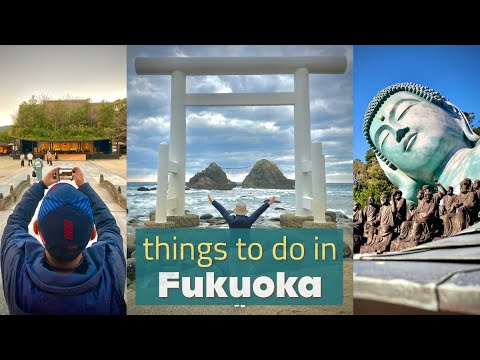In recent years, visitors to Japan have been increasingly looking to venture beyond the usual mega-cities of Tokyo, Osaka and Kyoto. One city that has been progressively attracting international arrival is Fukuoka.
Kyushu is the third largest island in Japan, and one of the four main islands of the country. Fukuoka (city) has historically been the gateway to Kyushu and is its most populous city.
Join us, while we show you the Top Places to visit in Fukuoka!
(listed in random order)
#1: Kushida Shrine (00:41)
Located in the heart of Fukuoka city, this Shinto shrine was built in 757. It hosts the largest annual religious festival in the city, Hakata Gion Yamakasa.
#2: Nakasu Yatai Yokocho (Food Stalls Street) (00:56)
Within a short walking distance from Kushida Shrine, the small inland island of Nakasu is home to one of the most recognisable icons of Fukuoka, open-air food stands.
“Yatai” refers to food stands, while “Yokocho” refers to alleyways. Nakasu Yatai Yokocho (Food Stalls Street) is the most popular yatai in Fukuoka and is open on most days from 6pm till late. There are several food stands along the alleyway with each typically able to squeeze in 8-10 sitting diners at a time.
#3: Nanzoin Temple (01:19)
Nanzoin is a Buddhist temple in the town of Sasaguri, Fukuoka. It is home to the biggest (41m length) Reclining Buddha bronze statue in the world.
#4: Dazaifu Tenmangu Shrine (01:45)
Dazaifu Tenmangu is a Shinto Shrine in Dazaifu that is dedicated to Tenjin, the deified form of Michizane. Of the hundreds of Tenmangu Shrines in Japan, Dazaifu Tenmangu is considered among the top two most important.
Dazaifu Tenmangu is built over the grave of Sugawara no Michizane (845–903), a famed scholar, poet and politician. Due to his great learning, Michizane has been associated with Tenjin, a Shinto deity of education. The shrine is popular among Japanese students and many visit it to pray for success in their upcoming exams.
#5: Raizansennyoji Taihioin Temple (02:16)
Founded in 178 by an Indian Buddhist monk named Seiga, the temple was dedicated to imperial worship during the Mongol invasions of Japan in the Kamakura period. It is also known as the Kannon of Raizan due to its impressive statue of the goddess of compassion, embellished with 1000 arms and hands, with an eye engraved in each palm.
#6: Sakurai Shrine Futamigaura Torii (02:55)
A 45-minute drive from central Fukuoka city, Sakurai Shrine Futamigaura Torii has one of the 100 most beautiful sunset views in Japan. Approximately 150m from the beach, two giant rocks (joined by a shimenawa rope) and a magnificent white torii gate have attracted many visitors from both domestic and international.
The two rocks are believed to represent Japanese deities Izanagi and Izanami, while the shimenawa rope symbolises the union and connection between them. As such, the rocks are popular for their representation of marital happiness and matchmaking.
Date visited: Nov-2023
+++
Our website:
https://www.BalukooTravel.com
Follow us on
Facebook: https://www.facebook.com/balukootravel
Instagram: https://www.instagram.com/balukootravel/
Pinterest: https://www.pinterest.com/allanseetoh/
Twitter: https://twitter.com/BalukooTravel
+++
Music Credit
Track: Lotus — Ason ID [Audio Library Release]
Music provided by Audio Library Plus
Watch: https://www.youtube.com/watch?v=d4C5OV9hFXY
Free Download / Stream: https://alplus.io/lotus
+++
#thingstodofukuoka #selfdrivefukuoka #fukuokaitinerary

